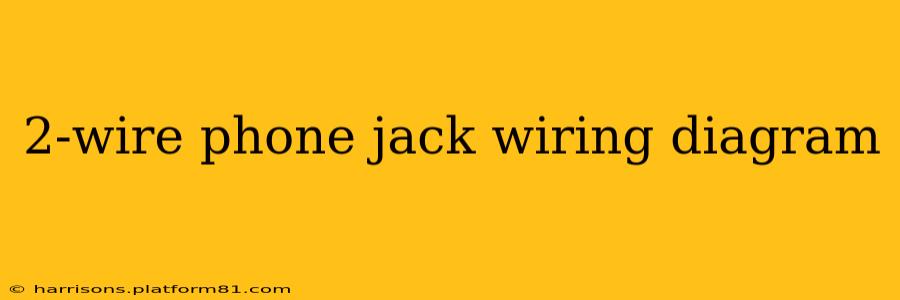Connecting a phone line to your home or office often involves understanding the wiring of a 2-wire phone jack. This seemingly simple connection plays a crucial role in ensuring clear communication. This guide provides a comprehensive overview of 2-wire phone jack wiring diagrams, addressing common questions and concerns.
What is a 2-Wire Phone Jack?
A 2-wire phone jack, also known as a RJ11 connector, is the standard interface used to connect telephones to a telephone line. Unlike some more complex connectors, it utilizes only two wires to transmit voice signals. These two wires carry the audio signals in opposite directions, allowing for a two-way conversation. While it may seem basic, the correct wiring is critical for a functional connection.
Understanding the Wiring Diagram: Pins and Colors
The RJ11 connector has six possible positions, although a 2-wire connection only uses two of these. While color-coding isn't always standardized, the most common arrangement uses the following:
- Tip (Pin 1): Usually red or green, this carries one direction of the audio signal.
- Ring (Pin 2): Usually green or red (opposite to Pin 1), this carries the audio signal in the opposite direction.
Important Note: While the colors typically correspond as described above, there may be variations depending on the manufacturer or age of the wiring. Always double-check your existing wiring before making any changes.
How to Wire a 2-Wire Phone Jack: A Step-by-Step Guide
While professional installation is always recommended for complex setups, wiring a simple 2-wire phone jack is a manageable task for DIY enthusiasts. However, always disconnect the power to the line before attempting any wiring.
- Gather your materials: You'll need a 2-wire phone jack, a punch-down tool, and the appropriate wiring.
- Identify the wires: Determine which wire corresponds to Tip (Pin 1) and Ring (Pin 2). Refer to your existing wiring or your telephone provider's instructions if unsure.
- Connect the wires: Carefully insert the wires into the correct terminals on the phone jack. Use the punch-down tool to secure the wires firmly.
- Test the connection: After wiring, plug your phone into the jack and make a test call to ensure the connection works properly.
Troubleshooting Common Problems
Even with careful wiring, problems can occur. Here are some common issues and troubleshooting tips:
No Dial Tone:
- Check the wiring: Carefully review the wiring diagram and ensure the connections are secure and correct.
- Check the phone line: Verify that the phone line is active and functioning correctly by testing with a different phone or jack.
- Check the wall jack: Make sure the wall jack itself isn't faulty.
Poor Sound Quality:
- Check for loose connections: Ensure all wires are securely connected.
- Check for interference: External factors, such as nearby electrical devices, can sometimes interfere with the signal.
- Test with a different phone: If the problem persists after checking the connections and eliminating interference, try using a different phone to rule out a faulty handset.
What are the different types of phone jacks?
While this guide focuses on 2-wire phone jacks (RJ11), it's important to know there are other types, particularly the RJ14 (used for two lines) and RJ25 (used for three or four lines). These connectors have more pins and more complex wiring schemes.
Can I use a different type of cable with a 2-wire phone jack?
Using the incorrect cable type may not work, and could even damage your equipment. Stick to cables specifically designed for telephone lines and RJ11 connections.
Where can I find a wiring diagram for my specific phone jack?
The most reliable source for a wiring diagram is the manufacturer's documentation or the instructions that may have come with your phone jack.
This comprehensive guide provides a thorough understanding of 2-wire phone jack wiring diagrams, equipping you to tackle simple phone line connections. Remember, if you're uncomfortable working with electrical wiring, always seek professional assistance.
